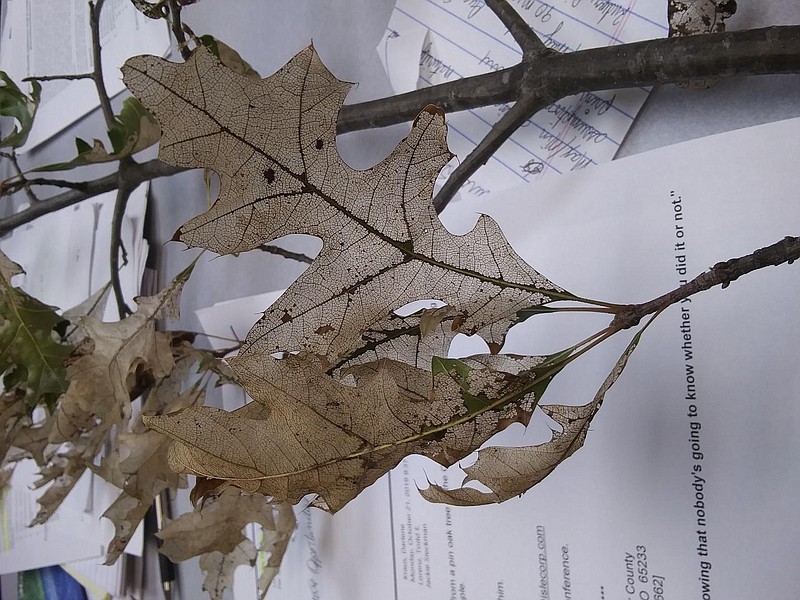Q. Any idea which insect would window pane a pin oak this time of year? Is it a problem?
A. That would be the "oak skeletonizer" (from our University of Missouri publication, common insects, pests on trees and shrubs M145, which is unfortunately NOT available online). It describes the symptoms as "portions of leaves are entirely consumed except for a layer of epidermis. Injured areas on the leaf are transparent." The culprit (Bucculatrix ainsliella) is a yellowish green caterpillar 5-6 millimeters in length when mature. The adult moths have a wingspan of 7-8 millimeters; the forewings are largely blackish with some paler areas in them. A publication by Cornell University reported they prefer red oak. Caterpillars are an important food source for many songbirds, thus this native insect has a role in the environment. Only if severely damaging a small tree would it be worth considering applying an insecticide. This late in the season, there would be no reason to do so; just let nature take its course.
Q. I was cutting back my Dahlias and found this stuff inside the stalk that looked like insect eggs? Could you help determine what it is?
A. Thanks for sending two good photos. That is caterpillar frass (poop) from a stem borer. I couldn't find that stem borers are a common problem on dahlias, I did find them mentioned in an article on the subject from a reputable source: extension.umd.edu/hgic/topics/borers-flowers. Of the stem borers reviewed, I would suspect European corn borer as they seek other similar green stalks to corn, as the corn plants dry down. So the timing would be right for this.
Q. My arborvitae has this weird brown stuff on leaves. What is it? Is it a problem?
A. Those are simply the dried up seed pods which have opened up and dropped its seed. No problem at all. Thanks for dropping a sample for me to see.
Q. Something chewed off about half of the bark on this small tulip tree we planted last fall. We put tree wrap on it for the winter but took it off for the growing season as we were told to. It grew well this summer, and now this. Will it survive? What did it? What can we do?
A. Thanks for sending a photo and it is good the damage was up and down the small trunk, not around. The best match for the damage just gave me another reason to hate squirrels. The Morton Arboretum of Chicago has a description for common animal damage as follows:
"During the summer, squirrels may occasionally strip bark from main stems and larger branches for nesting material. The squirrel is a very crafty animal, so control is difficult and is seldom fully effective."
What to do: First, put the trunk wrap back on the tree in case the varmint decides they want more. Now the bad news: The tree had about 50 percent of the bark removed and that is on the edge of what they can recover from. On the plus side, we are going into a season where moisture needs are low, and it can recover some until April. To help it recover you can wash with soap and water and then rinse well with water. Then trim away obviously damaged bark. Since it is a small tree, be very careful and don't take away much. Check back in the spring after you remove the wrap. You might get some idea from its healing if you should clean up the wound more. Sealants, tar or similar are no longer recommended.
Q. I have only one pear tree; I can't remember the cultivar. But it produces fruit, and I thought pears need to be cross-pollinated. Is it getting pollinated by other pears? The only ones I see around my yard are Bradford pears.
A. Good question, and I had to look into this a bit as, yes, we advise two different pears that match in flowering time, so at they cross-pollinate. It turns out quite a few pears appear to be "partly self-fertile." When pollination is required, it needs to be by the same species so a definite NO to an eating quality pear being pollinated by a Bradford pear. Even when a tree is partly self-fertile, it will generally have great fruit set if nearby a compatible cultivar. Asian and European pears are different species, so don't cross-pollinate.

